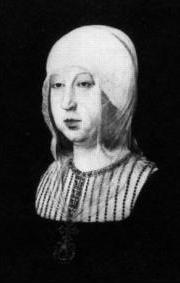Isabella I the Catholic (Spanish: Isabel la Católica)
Queen of Castile and of Aragon, b. 22 April 1451 (Madrigal de las Altas Torres, Spain), d. 26 November 1504 (Medina del Campo).
 Isabella was the daughter of John II of Castile and of Isabella of Portugal. Her elder half brother became king Henry IV of Castile when she was three years old. When her younger brother Alfonso died in 1468, Henry IV declared Isabella successor to the throne.
Isabella was the daughter of John II of Castile and of Isabella of Portugal. Her elder half brother became king Henry IV of Castile when she was three years old. When her younger brother Alfonso died in 1468, Henry IV declared Isabella successor to the throne.
The 17 year old Isabella was valuable property for the foreign policy of the royal court - her marriage could vastly expand the kingdom. But Isabella decided to sidestep various suitors and married Ferdinand II of Aragon without Henry's approval. Henry withdrew from the earlier succession agreement in favour of his daughter Joan, who was to be married to a French aristocrat. The War of the Spanish succession broke out as soon as Henry IV died in 1574.
Isabella was declared queen of Castile, but the first four years of her reign were dominated by civil war. By 1478 she had asserted her authority. In 1479 king John II of Aragon died, and Isabella became queen of Castile and Aragon, to reign jointly with her husband Ferdinand II.
The union of Castile and Aragon was the first step in the formation of a unified Spain. In 1482 Isabella and Ferdinand decided to invade and regain the Muslim kingdom of Granada for Spain. It proved harder than anticipated, but Granada fell on 2 January of 1492. In the same year Isabella agreed to support the voyage of Christopher Columbus to the "New World", a decision that enlarged Spain many times over through overseas colonial possessions.
The expansion of the Spanish kingdom was accompanied by a strengthening of authoritarian rule to secure the position of the aristocracy and the Catholic church. (The boundary between the two was quite blurred; the daughters and second sons of the aristocratic houses provided the bishops, archbishops and priors of religious orders.) Isabella took a personal interest in the rules and life of the religious orders, and she and her husband had the de facto power to appoint bishops.
An important instrument of Isabella's interior policy was the Spanish Inquisition established in 1478 by Pope Sixtus IV. It ruthlessly persecuted Muslims and Jews, forcing them to convert to Catholicism. Those who refused were driven out of the country; 2,000 or more were burnt at the stake. The loss of the Jewish communities led to a severe weakness of the economy. As a result of the Inquisition Spain remained the centre of reactionary politics in Europe for more than a century.
In Spanish history Isabella I is highly regarded as the sovereign who achieved the unification of the country. Her decision to support and finance the expedition of Columbus was without any doubt courageous and far-sighted; few contemporaries would have been prepared to invest in a venture to travel to the limits of the known world without assurance of its success. Spain's large colonial empire goes clearly to her credit. But the ordinary people and people of other faiths suffered more under her reign than during other periods, and she was instrumental in defining Spain's reactionary role for the centuries that followed.
In 2003 the Catholic church began proceedings to declare Isabella I a saint.
Reference
Highfield, J. R. L. (1995) Isabella I. Encyclopaedia Britannica 15th ed.
 |
Queen Isabella I the Catholic in a nun's habit during penitence; by an unkown artist.
Real Academia de la Historia, Madrid. |
home
 Isabella was the daughter of John II of Castile and of Isabella of Portugal. Her elder half brother became king Henry IV of Castile when she was three years old. When her younger brother Alfonso died in 1468, Henry IV declared Isabella successor to the throne.
Isabella was the daughter of John II of Castile and of Isabella of Portugal. Her elder half brother became king Henry IV of Castile when she was three years old. When her younger brother Alfonso died in 1468, Henry IV declared Isabella successor to the throne.